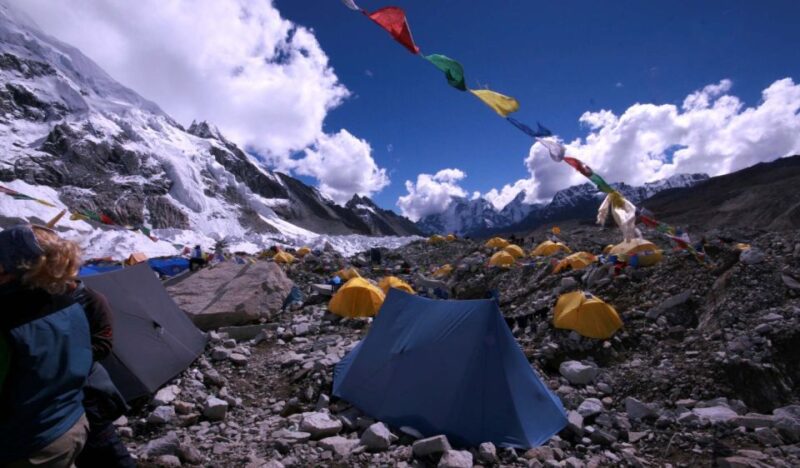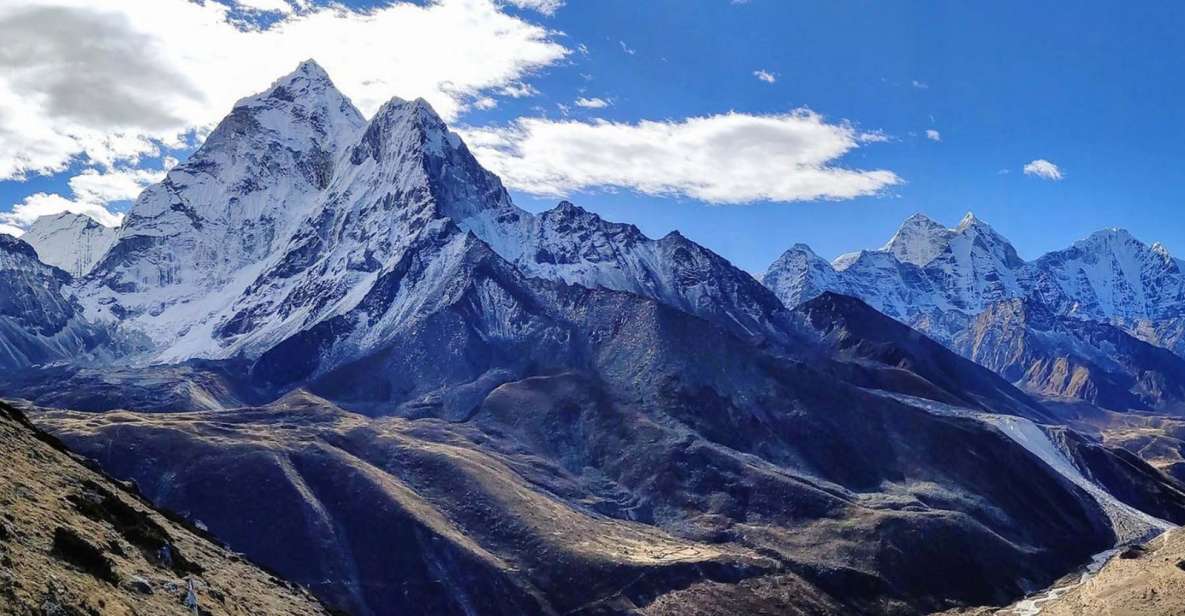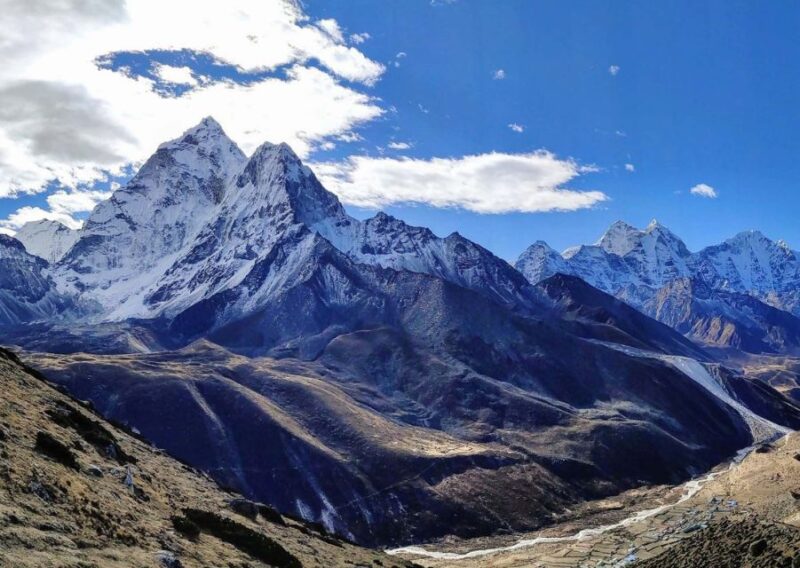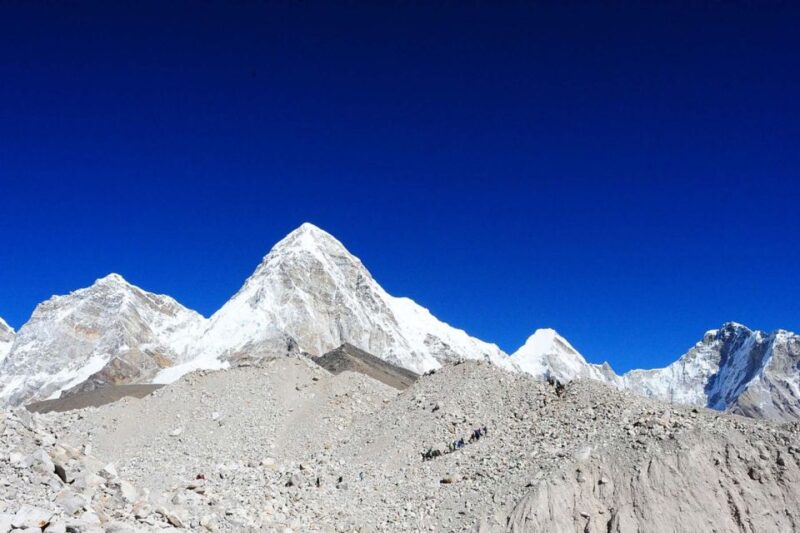When planning the Everest Base Camp Trek from Kathmandu, travelers often find themselves navigating a blend of breathtaking landscapes and rich Sherpa culture. Starting with a thrilling flight to Lukla, the journey unfolds through vibrant villages like Namche Bazaar, where trekkers can enjoy local traditions. Acclimatization days are vital to tackle the altitude, and the views from Kala Patthar are nothing short of spectacular. Yet, understanding what to pack and the best time to embark on this adventure can make all the difference in ensuring a smooth trek. What should they consider before setting off?
Key Points

- The Everest Base Camp Trek lasts 12 days, starting with a flight from Kathmandu to Lukla.
- The trek includes acclimatization days in Namche Bazaar and Dingboche to adjust to high altitudes.
- Key highlights include visiting Tengboche Monastery and enjoying views of Ama Dablam and Everest.
- The trek features cozy teahouse accommodations with guided support and necessary permits included.
- Optimal trekking seasons are spring (March-May) and autumn (September-November) for the best weather and views.
Overview of the Trek

The Everest Base Camp trek offers adventurers an unforgettable journey through the breathtaking Khumbu region of Nepal, combining stunning landscapes with rich Sherpa culture. Spanning 12 days, this trek challenges hikers with diverse terrains, from lush forests to rocky paths, all while showcasing the majestic Himalayas.
Starting at around $1,425.70, travelers can enjoy a flexible booking policy, including free cancellation up to 24 hours in advance. As trekkers pass through charming villages like Namche Bazaar, they’ll enjoy local traditions and hospitality.
It’s essential to prepare adequately, as altitude can be a concern. Embracing the journey means not just reaching the base camp but also appreciating the vibrant culture and breathtaking views along the way.
You can also read our reviews of more hiking tours in Nepal
Detailed Itinerary

Embarking on the Everest Base Camp trek means following a carefully crafted itinerary that balances adventure with acclimatization, ensuring trekkers can fully enjoy the breathtaking scenery and rich Sherpa culture along the way.
The journey kicks off with a flight to Lukla, followed by a trek to Phakding and onward to bustling Namche Bazaar. Acclimatization days in Namche and Dingboche allow trekkers to adapt while soaking in local culture.
Iconic stops like Tengboche Monastery and the stunning views of Ama Dablam create unforgettable moments. After reaching Base Camp, trekkers ascend to Kala Patthar for sunrise views.
The trek wraps up with a celebratory return to Lukla, marking an incredible achievement and a deeper appreciation for the majestic Himalayas.
Trekking Inclusions

Included in the Everest Base Camp trek are essential services and amenities that ensure trekkers have a comfortable and enjoyable experience throughout their journey in the breathtaking Himalayas.
The trek covers flights from Kathmandu to Lukla and back, along with private ground transport. Trekkers stay in cozy teahouses on a twin-sharing basis, enjoying the warm hospitality of local communities.
An experienced trekking guide and porter accompany the group, making the trek smoother. Essential permits and fees are taken care of, and trekkers receive warm gear like down jackets and sleeping bags.
After the trek, they can unwind with a massage and enjoy a farewell dinner, celebrating their incredible adventure together.
Trekking Exclusions
When planning your Everest Base Camp trek, it’s important to be aware of certain exclusions that could impact your overall experience and budget.
First off, don’t forget about the Nepalese visa fee and any potential excess baggage charges if your gear exceeds 15 kg.
Meals in Kathmandu and during the trek aren’t included, so budgeting for those is a must.
Also, international flights and travel insurance are on you, as well as any personal expenses like laundry or phone calls.
If you need extra accommodation in Kathmandu due to itinerary changes, that’ll cost extra too.
And remember, tipping your guide and porter is customary, so set aside a bit for that as well.
More Great Tours NearbyParticipant Requirements
Understanding the participant requirements is key to ensuring a smooth and enjoyable Everest Base Camp trek. This trek isn’t suitable for children under 10 or anyone over 95, as the altitude and physical demands can be tough.
Participants should be in good health and have a reasonable level of fitness; regular hiking experience is a plus. It’s crucial to check availability for the desired dates and ensure all gear is ready for the journey.
Embracing the local culture is part of the experience, so being open-minded and respectful towards Sherpa traditions enriches the trek.
Lastly, participants should stay flexible, as weather and trail conditions can change, impacting the itinerary.
Best Time to Trek
The best times to trek to Everest Base Camp are typically during the spring (March to May) and autumn (September to November) when the weather is more stable, offering clearer skies and milder temperatures.
Spring brings blooming rhododendrons, creating vibrant landscapes, while autumn showcases stunning mountain views as the air becomes crisp.
Trekking during these seasons not only enhances the experience but also allows trekkers to encounter a lively atmosphere with fellow adventurers.
While winter (December to February) can be harsh and summer (June to August) tends to be rainy, those willing to brave the elements might find solitude and unique challenges.
Ultimately, choosing the right season can significantly impact the overall trekking experience and enjoyment.
Packing Essentials

With the best times to trek to Everest Base Camp being in spring and autumn, having the right gear makes all the difference in ensuring a comfortable and enjoyable journey.
Essential items include a sturdy pair of trekking boots, moisture-wicking clothing, and a warm down jacket for chilly nights.
Don’t forget a reliable backpack, a good sleeping bag, and trekking poles to ease the strain on your knees.
Layering is key; it allows trekkers to adjust to changing temperatures easily.
Also, pack a reusable water bottle and purification tablets to stay hydrated.
Lastly, consider bringing a camera to capture the breathtaking landscapes and rich Sherpa culture along the way.
Happy trekking!
Travel Tips and Advice
Planning for the Everest Base Camp trek can feel overwhelming, but a few handy tips can make the adventure smoother and more enjoyable.
First, acclimatization is crucial; don’t rush it. Spend extra time in Namche Bazaar and Dingboche to adjust.
Next, pack light but smart—layers are key for fluctuating temperatures. Hydration‘s important too; drink plenty of water to avoid altitude sickness.
Embrace local culture by learning a few basic Nepali phrases; it shows respect and can enhance interactions.
Lastly, don’t forget to tip your guide and porter—they work hard to ensure your experience is memorable.
With these tips in mind, trekkers can focus on the breathtaking views and unforgettable experiences that await in the Himalayas.
Frequently Asked Questions
What Is the Fitness Level Required for the Trek?
For this trek, participants need moderate fitness. Regular walking, hiking, or cardio workouts help. Acclimatization’s vital too, so they should prepare for altitude by gradually increasing their stamina and endurance before departure.
Are There Age Restrictions for Participants?
There’re age restrictions for participants; kids under 10 and individuals over 95 can’t join. It’s essential for everyone to be in good health to enjoy the trek and fully embrace the experience.
How Do I Prepare for Altitude Sickness?
To prepare for altitude sickness, he should gradually ascend, stay hydrated, and consider acclimatization days. Eating light meals and avoiding alcohol can help, too. Listening to his body’s signals is crucial during high-altitude adventures.
Is Wi-Fi Available During the Trek?
While Wi-Fi’s available in some teahouses, it’s often slow and unreliable. Travelers should expect limited connectivity, so they shouldn’t depend on it for important communications. Embracing the adventure means enjoying the beautiful surroundings instead!
Can I Customize My Trekking Itinerary?
He can absolutely customize his trekking itinerary! Many trekking companies offer flexibility to adjust routes, durations, and accommodations, ensuring a personalized experience that aligns with his interests and adventure goals. It’s worth discussing options upfront.
Recap
The Everest Base Camp Trek from Kathmandu is an adventure of a lifetime, blending stunning landscapes with rich Sherpa culture.
With the right preparation, trekkers can fully embrace the challenges and rewards of this incredible journey. Remember to take it slow, soak in the breathtaking views, and connect with the locals.
Whether you’re standing at Base Camp or gazing at Everest from Kala Patthar, the memories made here will last forever.
So lace up those boots and get ready for the experience!
You can check availability for your dates here:More Hiking & Trekking Tours in Nepal
More Tour Reviews in Nepal
Not for you? Here's more nearby things to do in Nepal we have reviewed
- Himalayan Sound Healing Workshop: Singing Bowl in Nepal.
- Nepal: Api Himal Trek to Base Camp
- Rolwaling Himal Trek 8 Days
- 10 Days Annapurna Circuit Trekking
- Indra Jatra Tour in Nepal
- Nagarjun Jamacho Day Hike Stunning Valley Himalayan Views
- Chitwan National Park Tours: 3 Nights 4 days Full Package
- Kathmandu-Pokhara Night Sofa Bus
- 10 Best Guided Tours In Nepal
- 25 Best Tours In Nepal
- 10 Best National Park Tours In Nepal
- Sunrise View From Sarangkot
